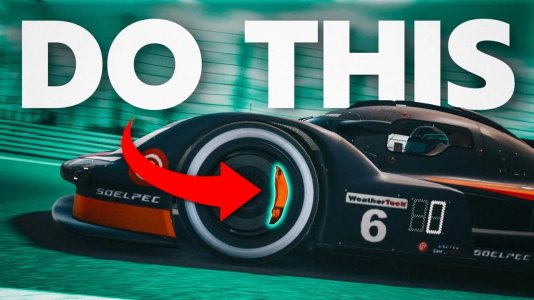Steering, throttle and brake - three core elements of sim racing that seem simple. There is a lot of time to be found on the brakes in particular, though, as our sim racing braking guide shows.
Every sim racer has their own driving style, meaning they approach different scenarios in a different way. However, there are certain core elements that if done right can find you good chunks of time when out on track - and probably none more important than braking.
To help you get the most out of your car when on the brake pedal, our resident rapid iRacer Markus Søholm takes a look at what hard-to-spot habits to eliminate, how to adjust your brake balance, trail braking, and more. The cool thing is: Most of the things Markus recommends are easy to implement into your driving style - although some practice might be required.
In short, here are Markus' top tips for braking in sim racing:
Avoid Overlaps
Inputs for brake and throttle should not happen at the same time. This can easily happen when lifting of the throttle and hitting the brakes already, leading to a brief moment of both inputs being made at the same time. To try and get rid of this habit, lifting and coasting like you would to save fuel in endurance racing can help build the muscle memory - first let go of the throttle entirely, then apply the brakes.Most modern race cars, like the Corvette Z06 GT3.R feature lights to visualize that ABS or Traction Control have been triggered. In this case, the red box in the top right of the dash display is the ABS indicator.
Apply The Right Amount Of Brake Pressure
Many modern racing cars have ABS that prevents your tires from locking up, but that does not mean you should fully use it under braking. Instead, try to find the threshold of the ABS kicking in - Markus recommends 80 to 90% of the full brake pressure for ABS cars as a baseline. In non-ABS cars, you will quickly find out how much is too much, as your tires will simply start locking.Avoid Micro Lockups
Difficult to notice but not helpful for your tire life, micro lockups often occur when still trail braking and turning towards the apex. The tires do not fully lock up, but do so very slightly, which hurts both tire life and your lap time. Going just that bit easier on the brakes at this stage can help with this problem.Trail Braking
Arguably the most important part of braking, trail braking means braking hard initially, then trailing off the brake pedal as the car slows down progressively to always have the most braking efficiency. Weight distribution is also important in this case - when trail braking, this slightly shifts towards the back of the car, adding more rotation which helps with cornering.Exhibit A: An Australian Supercar that would have slid straight past the apex had the driver been too eager on the brake pedal. Brake bias also varies depending on weight distribution - in a car like this with a heavy engine in the front, the brake bias should be shifted more to the front than in a mid-engined car.
Adjust Your Brake Bias
Brake bias can easily be adjusted from the cockpit in most modern cars. 50% brake bias means that your car is braking with the exact same force both on the front and the back tires. If you find that your car becomes unstable under braking (because the rear tires start locking up), adjust the brake bias forward (so increase the % value), and go the other way if you find your car to be locking the fronts frequently. Playing with this until you are comfortable when braking is an important factor for you to unlock more pace.This can differ from session to session due to conditions. Track grip, wind or, of course, rain, can all require re-adjustment of brake bias, plus an adjusted braking point as well. In the rain in particular, smooth application of the brake is very important.
Did Markus' braking tips help you? Got any of your own that might help the OverTake community? Let us know in the comments below!
